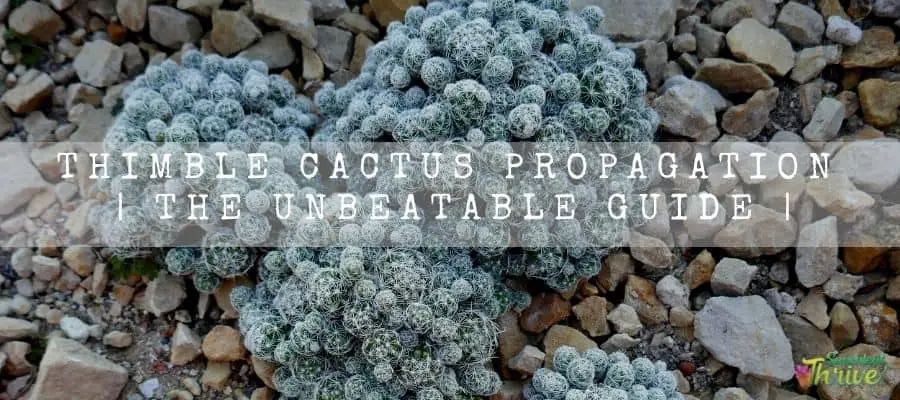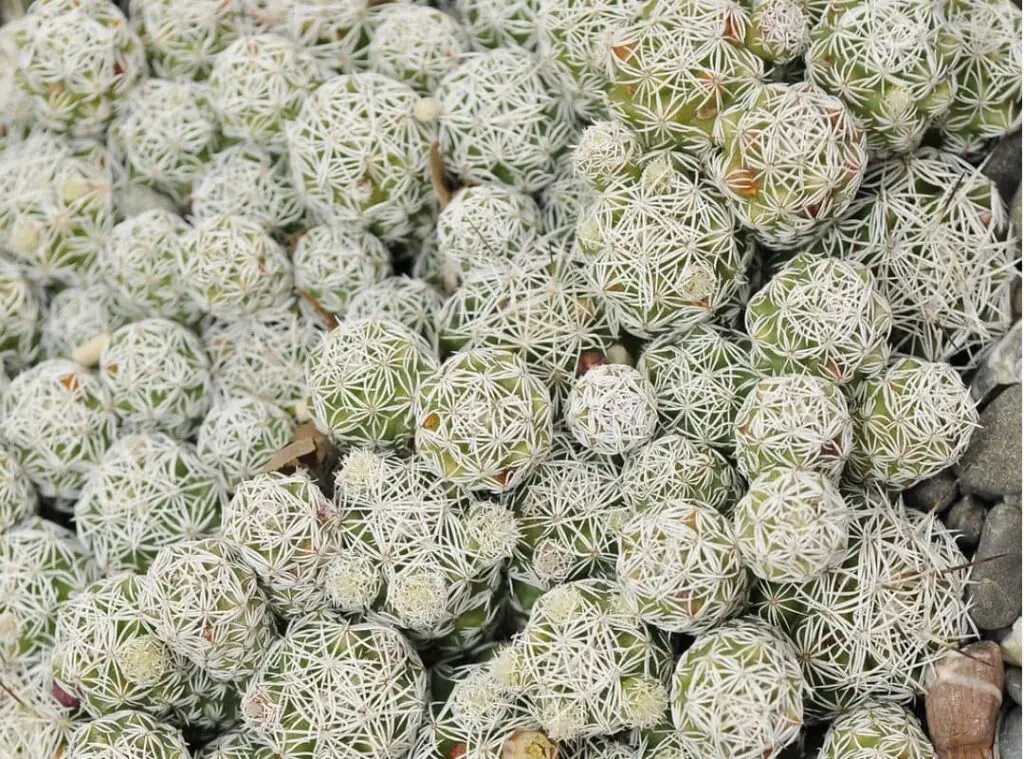You can conduct thimble cactus propagation by cuttings, using seeds or by offsets. But the easiest method is to use offsets.
In this guide I am going to discuss those propagation methods in detail

Thimble cactus is one of the most highly prized cacti which you may come across in the succulent cactus world.
Succulent lovers are fans of their traits in cultivation as well as in the attractive looks they have. Due to these features, many people are addicted to growing them as houseplants.
Thimble cacti are dwarf plants and usually grow in clusters. They would grace the entire space wherever you grow them.
Besides, they produce flowers in creamy yellow. And their flowering season would be summer. Further chances are that they may flower in winter too.
Can you propagate Thimble cactus ?
Yes you can propagate these cacti. You can use either seeds or offsets for the propagation process.
Can you propagate Thimble cactus by cutting?
First of all, you need to choose a healthy stem from the plant. To cut it, ensure that you are using all sterile tools.
You can use either a pair of scissors or a knife for this purpose. Once you obtain the cuttings, place them in a dry place where they can heal their cut wounds.
In the meantime, you need to arrange a pot with a potting medium which has excellent drainage.
Next, you can place the cuttings in the pot. When you place the cuttings, ensure that you insert the cuttings somewhat deep so that they can stay stable in the soil mix.
Once you place the cuttings, you need to water them moderately and place them on a windowsill where they can gain sufficient sunlight but not direct sunlight.
I suggest covering the specimen with a plastic bag here. Whenever you spot your cuttings are dry, you can water them.
It would take about one month’s time to produce roots and it will take a little longer to produce new growth.
Do they produce seeds?
Thimble cactus produce seeds which you can use for the propagation.
You can plant the seeds in sandy or slightly humid substrate. Ideal season to conduct propagation through the seeds method would be spring.
Do they produce offsets?
Thimble cactus produce offsets.
To propagate with offsets, you simply have to take off the offsets carefully and let them wither on a paper towel for about two days’ time.
During this process, you could spot them producing callousness over the cut wounds. Then, you can arrange a new pot and place the new plants in a pot in which you have filled it with cactus oil mix or with a succulent soil mix.
Place the specimen in a warmer place. Once you spot them, they have produced new roots, you can transplant them in regular containers.
Can you root the Thimble cactus in water?
You can propagate the Thimble cactus in water.
Many people tend to propagate the Thimble cactus in water as they find it less messy when compared to the soil propagation method.
The growing medium here would be water instead of soil. You can use the cuttings to propagate them in water and you can continue with the general practice you would do with other succulents when propagating the Thimble cactus in water.

How to treat after propagation
Sunlight requirement of the Thimble cactus
Majority of the succulents and cactus are sun loving plants.
They are fond of sunlight and if they keep growing without adequate sunlight, they will tend to grow leggy. Thimble cacti are no exception to that.
Literally it is crucial that they have sufficient sunlight to produce new growth and to stay healthy. With that being said, they can also thrive in moderate light conditions also.
The indoor grown Thimble cactus would happily grow if you had placed them near a bright sunny spot which could possibly be a windowsill at your home.
On the other hand, if you have some outdoor space, you can consider moving them out during such warmer times.
However, refrain from exposing them to direct sunlight though. If you had grown them outdoors, you may have to protect the plants from rainfall.
Temperature requirement of the Thimble cactus
Thimble cactus prefer to grow in warmer temperatures at all times.
Hence you can consider shifting them outdoors during summer. Once the temperature gets cooler, you can shift them indoors so that you can protect the plants from winter conditions.
Thimble cactus are hardy plants as they usually grow in the desert conditions in Mexico. They can grow vigorously despite how tough the growing conditions are.
If you slowly expose them to fluctuations in temperature, they can slowly adapt to them. In fact, they are tolerant of scorching temperatures and light frost for some time if you slowly expose them to such conditions.
The exposure to cooler temperatures during summer will make them look like such spectacular plants.
Soil requirement of the Thimble cactus
If you had grown them in the wrong soil mix, it would literally result in the death of the plants.
If you have failed to provide a well-draining soil mix, it will be fatal for them. Growing them in the right soil mix is very important when it comes to providing the right care treatments for them.
Many people tend to grow them in a soil mix which has balanced amounts of potting soil and perlite.
Be vigilant in selecting the right soil mix as if you grow them in a poor draining soil mix it would retain excess moisture in the pot and make the plants vulnerable to root rot.
Thimble cactus are drainage loving plants. Hence, you need to provide a substrate which has an excellent draining feature. You may go ahead with a succulent / cactus soil mix for this purpose too.
Right pot type for the Thimble cactus
Thimble cactus roots do not prefer to stay in damp conditions for too long as it will lead to root rot. As such I recommend you grow them in pots which have a draining hole.
There would be an exception for experienced succulent gardeners to grow them in pots which do not have draining holes so that they know how to handle them in such conditions.
Unglazed terracotta pots would work well with the Thimble cactus. Further, as aforesaid they need to have a draining hole as well.
So that it will allow the excess water to move through. Further, the porosity of the pots would be helpful for the evaporation of the excess moisture.
Besides, the good aeration would also help the plants to avoid staying in damp conditions.
Watering requirement of Thimble cactus
The key factor in providing the right growing conditions for the Thimble cactus is watering them properly.
Many beginners in succulent gardening will find it difficult to water them accurately though. The watering time depends on the lighting conditions and on the climate around the plants.
Thimble cactus have water conserved in their body and they can survive for some time even if you forget to water them once or twice.
Further when they are actively growing, you need to still water them only if you find their soil is dry only.
If you have outdoor grown Thimble cactus, you can consider watering them twice a week. Chances are that it could even be less than that too.
You can limit watering them during cooler periods of the year. In fact, you can limit it to just once a month watering.
Fertilizer requirement of Thimble cactus
You can consider feeding the Thimble cactus with a cactus fertilizer monthly when they are actively growing.
Never feed them during winter as if you end up feeding them during winter, it will pave the way for unnecessary troubles such as feed burns.
Conclusion
To wrap up on what we learnt from this article, Thimble cactus are versatile and hardy plants. Besides, propagating them is such a simple process.
If you practice the aforesaid simple steps when propagating them and if you ensure that you do the after-care tips, you will have successful results of the propagation and make new plants.
Read Next : Bunny Ears Cactus Propagation | By Cuttings, Seeds And Offsets | Baby Toes Succulent Propagation | 4 Effective Methods |
